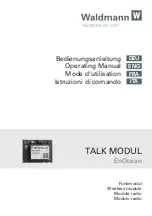
8 - 4
WiNG 5.7.1 Access Point System Reference Guide
5. The following
Events
can be filtered on behalf of the firewall:
Action
If a DoS filter is enabled, chose an action from the drop-down menu to determine how the
firewall treats the associated DoS attack. Options include:
•
Log and Drop
- An entry for the associated DoS attack is added to the log and then the
packets are dropped.
•
Log Only
- An entry for the associated DoS attack is added to the log. No further action
is taken.
•
Drop Only
- The DoS packets is dropped. No further action is taken.
Log Level
Select this option to enable logging to the system log. Then select a standard Syslog level
from the
Log Level
drop-down menu.
Ascend
Ascend DoS attacks are a series of attacks that target known vulnerabilities in various
versions of Ascend routers.
Broadcast/
Multicast ICMP
Broadcast or Multicast ICMP DoS attacks are a series of attacks that take advantage of
ICMP behavior in response to echo requests. These usually involve spoofing the source
address of the target and sending ICMP broadcast or multicast echo requests to the rest of
the network and in the process flooding the target machine with replies.
Chargen
The Chargen attack establishes a Telnet connection to port 19 and attempts to use the
character generator service to create a string of characters which is then directed to the
DNS service on port 53 to disrupt DNS services.
Fraggle
The Fraggle DoS attack uses a list of broadcast addresses to send spoofed UDP packets to
each broadcast address’ echo port (port 7). Each of those addresses that have port 7 open
will respond to the request generating a lot of traffic on the network. For those that do not
have port 7 open they will send an unreachable message back to the originator, further
clogging the network with more traffic.
FTP Bounce
The FTP Bounce DoS attack uses a vulnerability in the FTP “PORT” command as a way to
scan ports on a target machine by using another machine in the middle.
Invalid Protocol
Attackers may use vulnerability in the endpoint implementation by sending invalid protocol
fields, or may misuse the misinterpretation of endpoint software. This can lead to
inadvertent leakage of sensitive network topology information, call hijacking, or a DoS
attack.
IP Spoof
IP Spoof is an attack that sends IP packets with forged source addresses. This can hide the
identity of the attacker.
LAND
The LAND DoS attack sends spoofed packets containing the SYN flag to the target
destination using the target port and IP address as both the source and destination. This
will either crash the target system or result in high resource utilization slowing down all
other processes.
Option Route
Enables the IP Option Route denial of service check in the firewall.
Summary of Contents for WiNG 5.7.1
Page 1: ...WiNG 5 7 1 ACCESS POINT SYSTEM REFERENCE GUIDE ...
Page 2: ......
Page 3: ...WING 5 7 1 ACCESS POINT SYSTEM REFERENCE GUIDE MN001977A01 Revision A April 2015 ...
Page 4: ...ii WiNG 5 7 1 Access Point System Reference Guide ...
Page 24: ...1 4 WiNG 5 7 1 Access Point System Reference Guide ...
Page 36: ...2 12 WiNG 5 7 1 Access Point System Reference Guide ...
Page 72: ...3 36 WiNG 5 7 1 Access Point System Reference Guide ...
Page 470: ...5 386 WiNG 5 7 1 Access Point System Reference Guide ...
Page 472: ...6 2 WiNG 5 7 1 Access Point System Reference Guide Figure 6 1 Configuration Wireless menu ...
Page 624: ...7 46 WiNG 5 7 1 Access Point System Reference Guide ...
Page 724: ...9 56 WiNG 5 7 1 Access Point System Reference Guide ...
Page 783: ...12 35 Figure 12 46 Device Summary screen 4 Click File Management ...
Page 816: ...12 68 WiNG 5 7 1 Access Point System Reference Guide ...
Page 1006: ...13 190 WiNG 5 7 1 Access Point System Reference Guide ...
Page 1026: ...14 20 WiNG 5 7 1 Access Point System Reference Guide ...
Page 1028: ...A 2 WiNG 5 7 1 Access Point System Reference Guide ...
Page 1089: ......
Page 1090: ...MN001977A01 Revision A April 2015 ...
















































